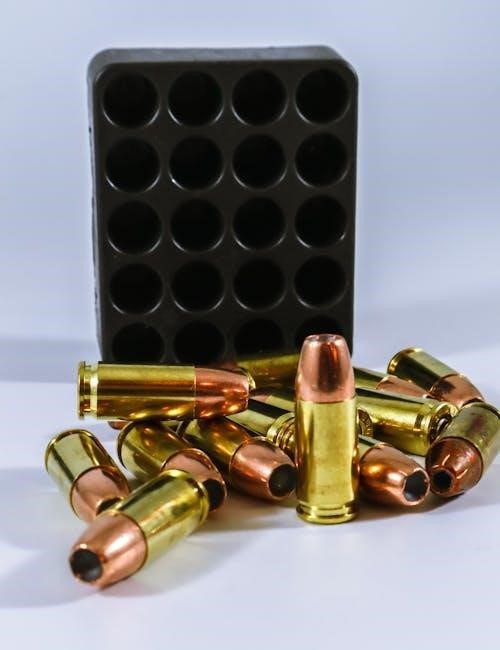Shotgun shell reloading allows shooters to customize loads for specific needs, offering cost savings and improved performance. It involves assembling hulls, powder, wads, and shot to create tailored ammunition.
What is Shotgun Shell Reloading?
Shotgun shell reloading is the process of assembling various components, such as hulls, powder, wads, and shot, to create customized shotgun ammunition. This process allows shooters to tailor their loads for specific applications, including hunting, target shooting, or home defense. By reloading, shooters can achieve cost savings, improve performance, and ensure consistent results. It requires precise measurements, proper tools, and adherence to safety guidelines to ensure reliability and safety of the reloaded shells. Reloading manuals and guides provide essential data for safe and effective reloading practices.
Benefits of Reloading Shotgun Shells
Reloading shotgun shells offers significant advantages, including cost savings, customization, and improved performance. Shooters can tailor loads to specific needs, such as hunting or target shooting, achieving better accuracy and effectiveness. Customization allows for precise control over shot size, powder charge, and wad selection, enhancing reliability and consistency. Reloaders can also experiment with different combinations to optimize patterns and velocity. Additionally, reloading extends the life of hulls and provides a cost-effective alternative to factory ammunition, making it a practical and rewarding hobby for shotgun enthusiasts.

Safety Precautions and Essential Equipment
Safety is paramount in shotgun shell reloading. Essential equipment includes a reloading press, scale, and powder measure. Always wear protective goggles and work in a well-ventilated area.
Safety Guidelines for Reloading
Adhering to safety guidelines is critical when reloading shotgun shells. Always wear protective eyewear and ensure the workspace is well-ventilated to prevent inhaling powder. Keep loose clothing tied back and avoid distractions. Use a reliable scale to measure powders accurately, as incorrect charges can lead to dangerous pressures. Follow established load data strictly, and never exceed recommended specifications. Regularly inspect equipment for wear and tear. Maintain a fire extinguisher nearby and avoid smoking or open flames. Prioritize meticulous attention to detail and patience throughout the process to ensure safety and reliability.
Required Tools and Equipment
Reloading shotgun shells requires specific tools to ensure accuracy and safety. A sturdy reloading press, shell holders, and dies are essential for resizing and crimping hulls. A precise powder scale and charge bar are critical for measuring propellant accurately. Wad and shot dispensers streamline the process, while a primer tool handles removal and installation. Hull polish and a dryer maintain shell condition. Safety gear, such as eyewear, is mandatory. Investing in a reliable scale with a stand and a reloading manual ensures consistency and adherence to safe practices. Proper equipment is vital for producing reliable, high-quality loads.
Understanding Shotgun Shell Components
A shotgun shell consists of a hull, primer, powder, wad, and shot. Each component plays a crucial role in performance and reliability.
Anatomy of a Shotgun Shell
A shotgun shell consists of several key components: the hull, which houses all parts; the primer, igniting the powder; the powder, providing propulsion; the wad, protecting the barrel and holding the shot; and the shot, the projectile. The hull is typically made of plastic or paper, with a brass base for durability. The wad acts as a seal and guides the shot. Modern shells may include multiple wads for better performance. Understanding each part is essential for safe and effective reloading, ensuring reliability and accuracy in various shooting applications.
Types of Shot and Wads
Shot types vary, with lead shot being traditional and versatile, while steel shot is denser and used for waterfowl. Bismuth and tungsten shots offer superior penetration. Wads are crucial for shot alignment and barrel protection. Overshot and undershot wads ensure proper shot dispersion. Materials like plastic and nitro cards are common, with slip-on wads reducing friction. Selecting the right shot and wad combination is vital for performance and pattern consistency, ensuring reliable results in various shooting scenarios.
Reloading Data and Load Recipes
Reloading data ensures safety and consistency. Reference manuals like Lyman and Alliant Powder provide detailed load recipes, including powder charges, wad types, and shot weights.
How to Read Load Data
Understanding load data is crucial for safe and effective reloading. Load data typically includes powder charges, shot weights, velocities, and pressures. Always reference reputable manuals like Lyman or Alliant Powder for accurate information. Pay attention to specific components like primers, wads, and hulls, ensuring compatibility. Start with minimum charges and gradually increase, monitoring performance. Cross-reference data with manufacturer guidelines to avoid errors. Record your loads and results for future reference, ensuring consistency and safety in your reloading process.
Factors Affecting Load Performance
Load performance in shotgun shell reloading is influenced by several factors, including powder charge weight, primer type, and wad selection. Environmental conditions like temperature and humidity can also impact powder burn rates and consistency. Shot type and size play a crucial role in patterning and range, while hull quality affects reliability. Proper component compatibility ensures optimal performance. Always adhere to established reloading guidelines and test loads incrementally to achieve desired results. Understanding these factors helps in customizing loads for specific shooting applications, ensuring safety and effectiveness.
Popular Load Recipes for Common Calibers
Popular load recipes for shotgun shells vary by caliber and application. For 12-gauge, common recipes include 1 oz. of shot with 16-18 grains of powder for target loads, or 1 1/8 oz. for hunting. Steel shot loads often use slightly less powder due to higher density. Always consult reloading manuals for specific data, as components like primers and wads must match the load. Customization allows shooters to tailor patterns and velocity for clays, upland game, or waterfowl, ensuring optimal performance in the field.
Step-by-Step Reloading Process
Reloading shotgun shells involves inspecting hulls, measuring powder, inserting wads, adding shot, and crimping. Each step requires precision to ensure reliability and performance in the field.
Inspecting and Preparing the Hull
Inspecting and preparing the hull is the first critical step in shotgun shell reloading. Examine the hull for cracks, dents, or worn-out crimps. Clean the hull thoroughly to remove residue and ensure a smooth reloading process. Use a hull cutter to trim damaged rims and a chamfering tool to smooth the edges. Properly preparing the hull ensures a secure fit for the wad and shot, preventing reload errors and improving overall performance. Always follow safety guidelines when handling hulls.
Measuring and Adding Powder
Measuring and adding powder is a critical step in shotgun shell reloading. Use a precise digital scale to measure the exact powder charge specified in your load data. Ensure the hull is clean and dry before adding the powder. Pour the powder slowly, avoiding overfilling; Double-check the measurement for accuracy, as incorrect charges can lead to unsafe pressures. For consistent results, use a powder baffle to guide the powder into the hull. Always refer to the reloading manual for the correct powder type and charge weight for your specific load.
Installing the Wad and Shot
After adding the powder, insert the wad into the hull, ensuring it is seated properly and aligned straight. Use the correct wad type as specified in your load recipe. Next, carefully pour the shot charge into the hull, filling it to the recommended level. Use a shot bushing if necessary to ensure accurate measurement. Gently tap the hull to settle the shot, then verify the shot column height with a depth gauge. This step ensures consistent patterns and performance when firing. Always follow the load data for the correct shot weight and wad combination.
Crimping the Shell
Crimping the shell is the final step in the reloading process, ensuring the wad and shot are securely held in place. Use a crimping tool designed for shotgun shells to form a tight, even fold or roll crimp at the mouth of the hull. A proper crimp prevents the shot from shifting and ensures consistent ignition of the powder. Different crimp types, such as roll or fold crimps, are used depending on the shell type and load recipe. Always follow the manufacturer’s guidelines for the correct crimp depth to maintain shell integrity and performance.
Final Inspection and Storage
After crimping, inspect the shell for defects, ensuring the crimp is secure and the shot is evenly distributed. Verify the overall weight and dimensions match your load recipe. Store reloaded shells in a cool, dry place, away from moisture and direct sunlight. Use protective boxes or sleeves to prevent damage. Label each box with the load details for easy identification. Proper storage maintains shell integrity and ensures reliable performance when shooting. Always handle reloaded shells with care to avoid damage and degradation over time.

Troubleshooting Common Issues
Identify and resolve issues like inconsistent patterns, low velocity, or misfires by checking powder charges, wad alignment, and primer seating. Ensure all components are compatible for reliable performance.
Identifying and Solving Reload Errors
Common reload errors include incorrect powder charges, improper wad seating, and primer misalignment. These issues can lead to inconsistent performance or safety hazards. To identify errors, inspect each shell for uniformity and ensure all components are seated correctly. Consult reloading manuals for specific troubleshooting guides. Adjusting powder measures and ensuring proper crimping can resolve many issues. Always test reloaded shells in small batches to verify performance and safety before producing larger quantities.

Advanced Reloading Techniques
Advanced techniques involve fine-tuning components, optimizing shot patterns, and experimenting with custom loads for specific applications, enhancing performance and reliability in various shooting scenarios.
Customizing Loads for Specific Applications
Customizing shotgun shells involves tailoring components like shot size, powder charge, and wad type for specific uses such as hunting, skeet shooting, or home defense. By adjusting these elements, reloaders can achieve optimal performance. For instance, denser patterns for hunting or tighter spreads for target shooting can be crafted. The Lyman Shotshell Reloading Handbook and other manuals provide detailed guidance on selecting the right components for desired outcomes, ensuring safety and effectiveness in each load.
Experimental Load Development
Experimental load development involves testing various combinations of powder, wads, and shot to create unique shotgun shells tailored for specific performance. Reloaders experiment with different charge weights and components to achieve desired velocity and pattern consistency. Detailed records and careful testing are crucial to ensure safety and reliability. This process allows shooters to optimize loads for applications like hunting or competitive shooting, enhancing effectiveness and accuracy. Always follow established guidelines to avoid unsafe configurations during experimentation.

Resources for Reloaders
Reloaders can access detailed manuals, online forums, and communities for guidance. Lyman Publications and Ballistic Products offer comprehensive reloading manuals and load data for shotgun shells.
Recommended Reloading Manuals and Guides
For precise and safe shotgun shell reloading, trusted manuals like the SKR Handbook of Shotshell Reloading (1984) and Lyman Shotshell Reloading Handbook are essential. These guides provide detailed load data, including powder charges, wad types, and shot weights. Digital resources, such as the Vihtavuori Reload app, also offer convenient access to reloading data. Additionally, downloadable PDFs like the Loadbooks 12 Gauge Shotshell manual are valuable for specific calibers. These resources ensure reloaders have accurate information for creating reliable and efficient shotgun shells.
Online Communities and Forums
Active online forums like Reddit’s r/Reloading and r/ShotgunReloaders offer valuable insights and support for shotgun shell reloading. These communities share tips, troubleshoot issues, and discuss load recipes. Websites like Ballistic Products and MEC Reloaders provide downloadable manuals and expert advice. Additionally, specialized platforms like the Vihtavuori Reload app offer digital tools for tracking and saving load data. Engaging with these resources fosters a connected community, ensuring reloaders stay informed and up-to-date with the latest techniques and safety guidelines.